Wondering how to write your first blog post?
It can be intimidating, especially if you don’t know what works and doesn’t work in online content.
Here are 17 tips to help you write your first blog post and connect with your readers.
Read the article all the way through and then use it as a checklist before you hit ‘publish.’
How to Write Your First Blog Post
Whether you aspire to become a professional blogger or simply want to create an online space to express yourself, writing your first blog post can be an exciting but daunting task.
The good news is that with the right guidance and a few fundamental principles, anyone can craft a compelling and engaging blog post that resonates with readers.
These seventeen tips will help you knock your first blog post out of the park.
#1. Define Your Audience
If you’ve defined your niche, you’ll know who your audience is. Choosing a well-defined niche is the most important thing you can do when starting your blog.
And this is where beginning bloggers make their biggest mistake – they go too broad. It’s almost always better to go narrow.
For example, if you’re starting hairstyling website, ‘hairstyling’ is way too broad. You’ll do much better with ‘hair styling for women over 50’. Likewise, ‘parenting tips’ is too broad. You’ll have much more success with ‘parenting tips for single mothers’. Here’s another example: ‘home decor tips’ is too broad. Instead, try ‘home decor tips for first home owners’.
With a narrow niche, you find your audience much quicker. And the reason is quite simple: you’ve already defined who your audience is. It’s ‘women over 50’ or its ‘single mothers’ or it ‘first home owners’.
When your target audience lands on your website, they immediately see that this website is aimed at them.
But not only that. With a narrow niche, you become an expert much quicker. Why? Because there are fewer experts to compete with. Also, with a narrow niche, Google will recognize you as an authority much faster.
You’ll be able build topical authority much faster for ‘parenting tips for single dads’ niche than for the ‘parenting’ niche. Likewise, you’ll build topical authority much faster for the ‘SEO for real estate agents niche’ than for the ‘SEO’ niche.
#2. Have the Right Attitude
If you don’t come from a writing background, writing for an audience can be scary.
But it’s good to remember that everyone, even blogging celebrities, once had to write their first blog post.
Accept that your first blog post is not going to be perfect. It may even be something that makes you wince in years to come.
But that doesn’t matter. The ‘child is father to the man’ as they say. The first faltering steps you take as an online writer will one day produce the polished, confident, and seasoned blogger that you will one day be.
#3. Introduce Yourself
Its not mandatory that you introduce yourself in your first blog post. After all, that’s what your ‘About’ page is for.
But if you do want to introduce yourself, here are some points you might want to mention in your first blog post:
- who you are
- why you started the blog
- who you will be writing for
- what sort of articles you’ll be writing
#4. Find a Topic To Write About
The best piece of advice I can give you here, is find a topic that people are searching for on Google. In other words, do your keyword research.
Another mistake that beginning bloggers make is writing content that doesn’t answer a need. Every time you publish an article, you need to answering a question, solving a problem, providing a solution.
And the way to find those questions that people are asking is through keyword research.
You can use a keyword research tool or you can simply use Google. Type your main keyword into Google Search. Then look at the long tail variations that Google comes up with in Google Auto Suggest. Those keyword variations that Google comes up with are all real-life search queries that people have typed into Google.
As a rule of thumb, the more words in your keyword phrase, the easier it will be to rank on Google for that keyword.
#5. Choose a Type of Blog Post
Choose what type of blog post you’re going to write. Here are some of the main types of blog posts:
List Posts
These blog posts have titles like ‘7 Things To Check Before You Hit ‘Publish’. They’re easy to write and easy to read.
Tutorials and Guides
These are in-depth blog posts that cover an entire topic in depth. The article you’re reading is a ‘complete guide’.
‘How To’ Posts
These are posts that show you how to a do a specific thing, such as create YouTube Header Art.
They usually contain step-by-step instructions and lots of screenshots.
Interview Posts
Interviews with experts in your niche are a popular type of blog post.
They’re quite easy to write, as the content comes from the expert responding to your questions.
Roundup Posts
These are a variation on Interview Posts. Ask a range of experts in a particular niche to give a one- or two-paragraph response to a simple question.
Then compile their responses into a blog post.
Review Posts
These posts compare two or more products and tell the reader which is best and why. These are great posts to write if you are marketing affiliate products.
Top List Posts
These are posts where you identify the top 20, 30, or 50 (etc) experts in a particular field.
Provide a brief description of what each expert specializes in or writes about. And that’s your article.
These posts are very effective in earning backlinks. The experts you mention in your posts will often include a link to your post on their ‘About Me’ page.
#6. Research Your Topic
Even if you know a lot about your chosen blog post topic, you should still do some research.
Why?
Because you’re trying to get your article ranked on Page #1 of Google. And that means your article will have to have at least as much topical authority as the other blog posts on Page #1.
So, go to Google search and type in your main keyword. Scan through the first 5 blog posts that appear in the search results.
Make a note of the headings. These are the sub-topics that the article is covering. I use a mind map for this, but you can also just note them down on a sheet of paper.
When you’ve finished, you’ll have a list of all the topics covered by the top 5 articles listed on Page #1 for your keyword.
You should now aim to write an article that covers all those topics topics.
By doing that, your article will have more topical authority than any of the top 5 articles on Page #1 of Google. And that’s going to give a huge SEO advantage to your blog post.
Now take the process to the next level:
Take your list of sub-topics and type each sub-topic keyword into Google. Look at the top 5 results for each of these sub-topic keywords and note down the sub-topics they cover.
These sub-topics and sub- sub-topics become the headings and sub-headings of your article.
It may seem like a lot of work.
But it’s better to spend a week writing one outstanding article than to spend half a day writing an average article.
The average article will never get on to Page #1 of Google. But the outstanding article will. And it will likely be there for years to come.
In summary, research is the key to getting your article ranked on Google.
#7. Write Your Blog Post
It’s one thing to have a great topic for your blog post. But writing an article that people actually want to read is another thing altogether.
There are 5 key elements in a blog post that people read from beginning to end.
Here they are:
- Hook
- Introduction
- Body
- Transitional phrases
- Conclusion
The Hook
The hook is the opening line of your article. And it’s the most important part of your article.
That’s because you only have about 3 seconds while your reader decides whether to stay or move on. The hook is what makes the reader stay and keep reading.
The hook is often a question. Questions work well as hooks, because a question demands a response. As soon as you ask a question it creates a response in your reader: they try to answer it.
And bam! They’re hooked.
These are the key characteristics of hooks that reel the reader in right from the first sentence.
Good hooks are:
- short and punchy
- often presumptuous (the writer seems to be getting inside your head)
- sometimes shocking
- often empathetic (the writer seems to know exactly what I’m feeling)
The Introduction
There are many ways to write a blog post Introduction, but there’s a three-step formula that works every time:
- present the problem
- point to a solution
- make a promise
Most successful bloggers use this formula in their Introductions. It works because people who find your article in the search engines have a problem and they’re looking for a solution. They want to know within a few seconds if your article is going to help them.
It would take a whole article to cover this topic properly – for more information on writing effective Introductions, see my article: How To Write a Blog Intro (4-Step Formula Works Like Magic).
The Body
This is where you set out the sub-topics of your article. Use headings and sub-headings to break up the text.
The body of your article should consist of short paragraphs. Each paragraph should contain no more than 3 or 4 sentences. And your sentences should be short.
Transitional Phrases
Transitions are little connecting phrases that link one paragraph with the next. They’re the lubricant that keeps your reader sliding down the page.
Here are some examples:
- You may be wondering at this point…
- But we’ll come to that later…
- Now, here’s the interesting part…
- So, what’s my point?
- You won’t believe what we discovered…
- But there’s just one problem…
- So, what’s the solution?
- But that’s not all…
- Case in point…
- Let me elaborate…
- Here’s what I mean…
- You’re about to find out…
- Stay with me now…
- Keep reading because I’m about to…
- But what exactly is…?
- Sounds good, doesn’t it?
For more information about transitional phrases see my article on SmartBlogger: How to Use Transitional Phrases to Keep Your Readers Sliding Down the Page
The Conclusion
In the Conclusion, sum up what you have said in the article. If the article is long, the reader will find it useful if you summarize the main points.
You can present the headings as bullet points, like this:
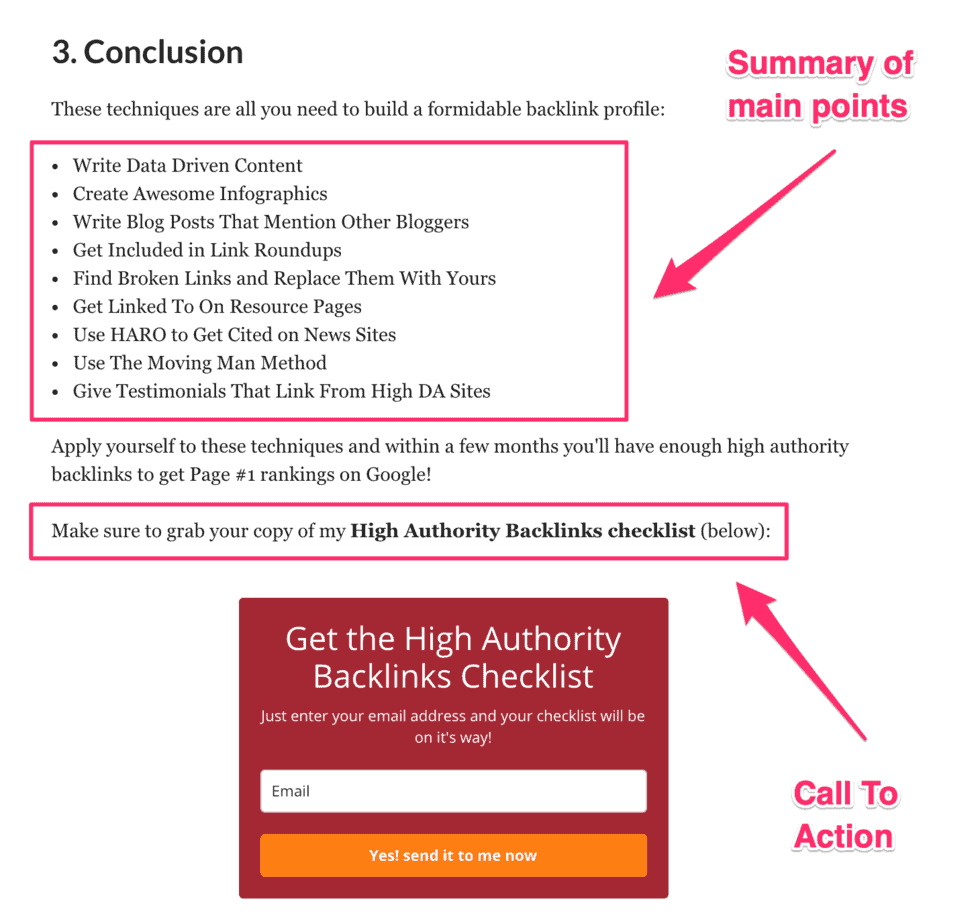
How To Write Your First Blog Post
Your conclusion should, if possible, contain a Call To Action (CTA) – what is it you want the reader to do after reading the post. It might be to:
- share the article on social media
- comment on the article
- bookmark the article
- review the article
- download a content upgrade
In the above example, I encourage the reader to download my checklist.
#8. Format Your Blog Post
The more time people spend on your page, the higher you will rank in the search results. And the best way to keep people on your page is to make your content easy to read.
Here are some ways to format your post to make it easier to read:
- break up your text by using short sentences and short paragraphs
- use plenty of headings and sub-headings
- use bullet points
- use lots of images, as they also break up the text.
- use transitional phrases to keep people reading from one paragraph to the next.
#9. Edit Your Blog Post
Always try to leave an interval of time between writing and editing, as they are two very different processes that use different mindsets. If you try to edit while writing, you will lack the objectivity you need.
There are two main editing steps I follow.
First, use the spell-checker in Microsoft Word or Google Docs. But be aware that it won’t pick up all your errors. Your text may contain words that are correctly spelled but shouldn’t be there, such as ‘bog’ instead of ‘blog’ or ‘their’ instead of ‘there’.
Next copy and paste your text into the Hemingway Editor. This is a great tool for cutting out ‘flab’: words that are not needed.
Hemingway picks up 5 types of errors:
- unnecessary adverbs
- passive voice
- complicated phrases
- sentences that are hard to read
- sentences that are very hard to read
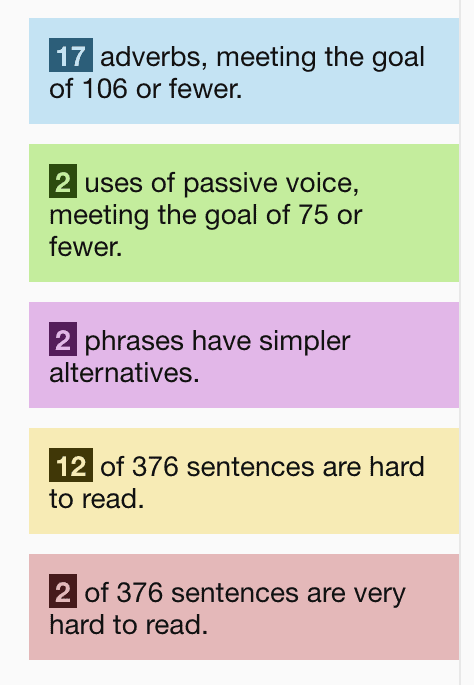
How To Edit Your First Blog Post
Hemingway will detect errors that slipped through Word’s spell-checker:

How To Edit Your First Blog Post
When Hemingway marks a sentence in yellow, you can usually cut it into two shorter sentences. If you have a tendency to write long sentences (as I do) this is really helpful!
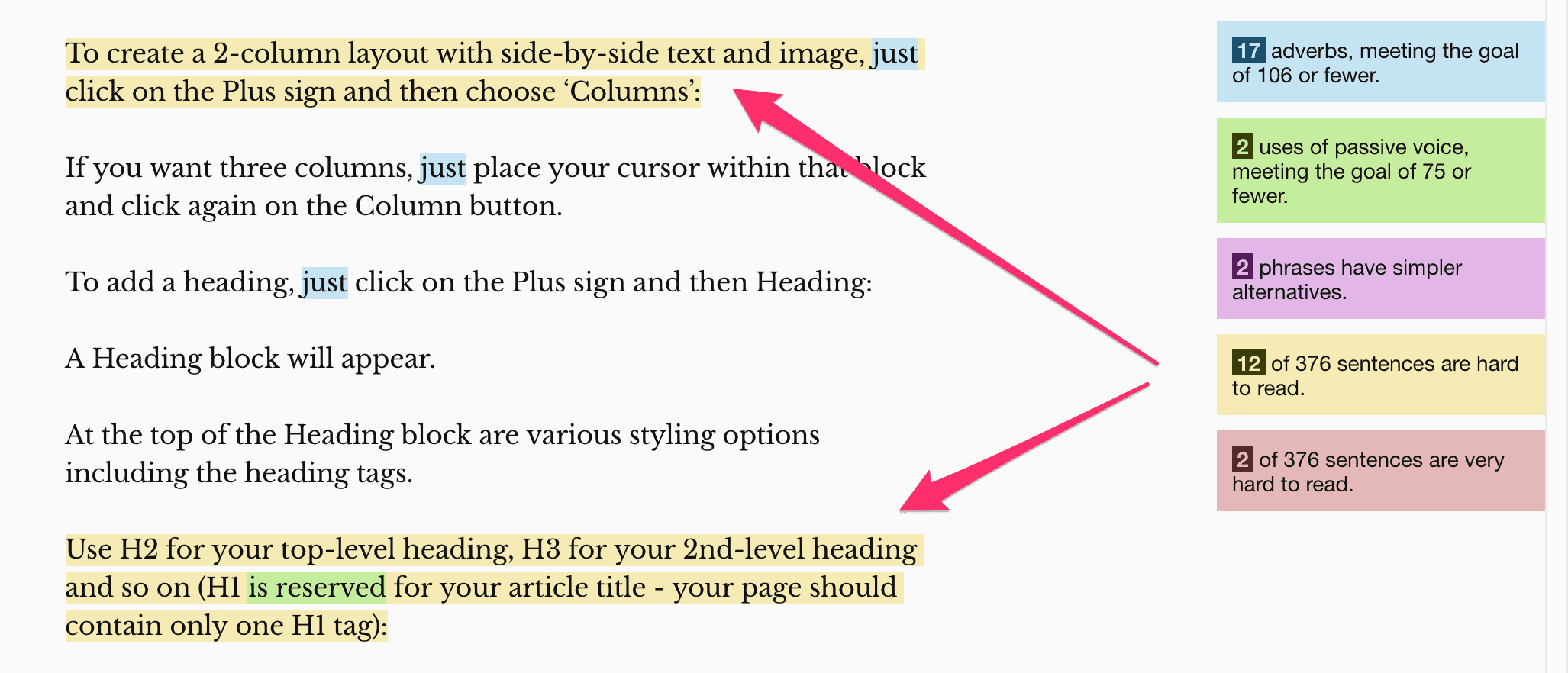
How To Edit Your First Blog Post
The Hemingway Editor also detects adverbs you don’t need:
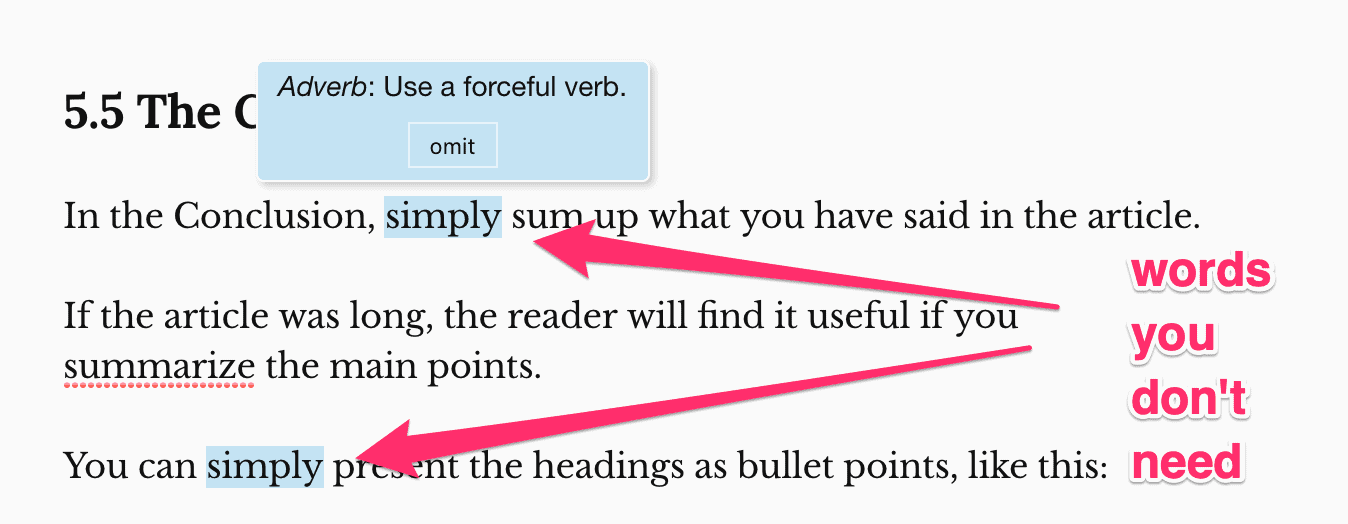
How To Edit Your First Blog Post
Using this tool, you’ll end up with shorter sentences and much tighter language.
And that’s going to make your article easier to read.
After passing your text through Hemingway, put it through the free version of Grammarly.
This is another great tool. It will pick some of those typos that the spell-checker missed:

How To Edit Your First Blog Post
#10. Write an Engaging Title
The most important tip on how to write your first blog post relates to the title of your article. Your title is what makes people click on your article in the search results. If the title is dull, most people will never even get to read the article.
So its vital to spend some time coming up with an eye-catching title. Here are seven tried and tested formulas for writing compelling blog post titles:
Formula #1: Get The Result Without The Pain
[Number] Secrets To [Desirable Result] Without [Painful Process]:
- 12 Secrets to Keeping Employees Happy Without a Raise
- 7 Secrets to Saying No (And Not Feeling Guilty About It)
- 18 Secrets to Make Your Food Healthier Without Even Trying
- 4 Secrets to Lose Weight Without Dieting
Formula #2: Little Known Ways In Record Time
[Number] Little Known Ways to [Desirable Result] In [Number] Days/Weeks/Months
- 8 Little-Known Ways to Find New Prospects on LinkedIn
- 12 Powerful Yet Little-known Ways to Prepare Your Child for Prep Success
Formula #3: You Should Know About This!
[Number] Things Everybody Ought to Know About [Keyword]
- 10 Things Everybody Ought to Know About Driving in the Rain
- 3 Things Everybody Ought to Know About a Last Will and Testament
- 5 Things Everybody Ought to Know Before Visiting the USA
Formula #4: Lessons I Learned
[Number] Lessons I Learned From [Keyword]
- 7 Important Life Lessons I Learned In 5 Years of Blogging
- 29 Lessons I Learned In Seven Years Of Living Abroad
- 7 Lessons I Learned From A Year Of Ethical Shopping
Formula #5: How To Survive Your First Anything
How to Survive Your First [Keyword]
- How to Survive Your First 3 Months of Blogging
- How to Survive Your First Year As a Teacher
- 8 Tips To Survive Your First Fire-fighter Shift
- How To Survive Your First Year As A Personal Trainer
Formula #6: Ten of These About That
[Number] of [Something] About [Something]:
- 10 Tips For Writing Better Blog Posts
- 23 Secret iPhone Tips and Hacks That You Didn’t Know About
- 7 Beach Hacks for Parents Who Hate to Struggle
Formula #7: What This Can Teach You About That
What [Something] Can Teach You About [Something]
- What Table Top Gaming Can Teach You About Course Design
- What Jackie Chan Can Teach You About Succeeding In Business
- 7 Things Your Day Job Can Teach You About Entrepreneurship
- What Learning Piano Can Teach You About Success In Business And Life
For more tips on writing blog post titles that people click on, see my article: How To Write Powerful Titles For Your Blog Posts – The Complete Guide
Here’s a free tool I use for every new blog post title: CoSchedule’s Headline Analyzer
It’s easy to use – just keep hammering out new titles until the indicator turns green:
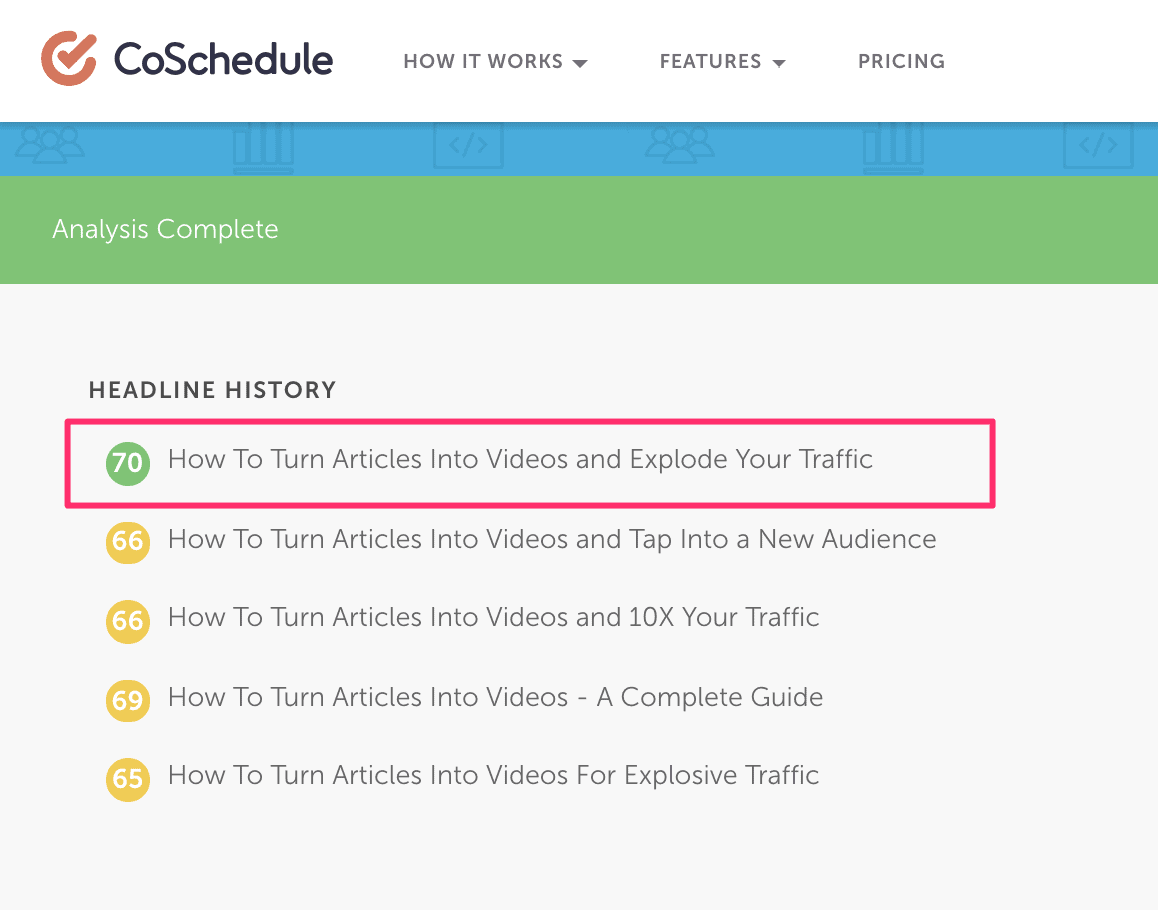
How To Edit Your First Blog Post
#11. Add a Call To Action (CTA)
Blog posts are like guided missiles. Or at least they should be. Every blog post should have a purpose: to get new subscribers, to increase reader engagement, to get shares on social media, or to get new clients for your service.
And that means your blog post needs a Call To Action (CTA).In most cases that’s going to be an opt-in form. But it could be a request to share your post on social media or a request to leave a comment.
Whatever you do, make sure your blog post asks the reader to do something. Otherwise, your blog post is not helping to grow your blog.
#12. Optimize for the Search Engines
Optimizing your article for SEO is a whole topic in itself. Here’s an article I wrote, titled: Search Engine Visibility – 21 Tips For More Search Engine Traffic.
A good start is to install the free Yoast SEO plugin.
Once the plugin is installed and activated, go to the edit screen for any specific blog post and follow the prompts until the Yoast indicator turns green:
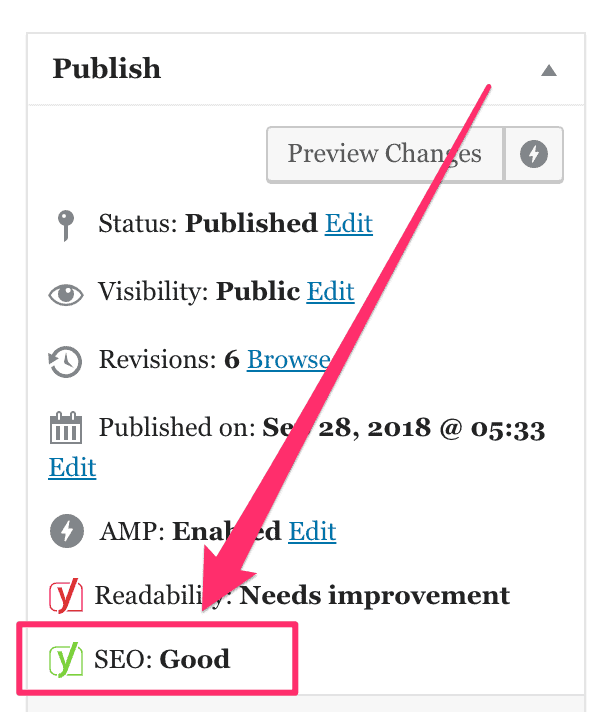
How To Do SEO for Your First Blog Post
Don’t worry too much about the Yoast ‘Readability’ score. Even with a perfectly written article, Yoast will mark you down if you have too many bullet points.
Here are some more SEO tips for optimizing your blog post:
#13. Embed a Video
The amount of time people spend on your page is one of the ranking factors that Google measures. The more time a visitor spends on your page, the more likely it is that your page answered their query
One easy way to get people to spend more time on your page is to embed a YouTube video on your page.
Here’s how to do it:
Go to YouTube and type in the keyword phrase of your article. Look for a video that has over 1000 views and also has a high ratio of ‘thumbs up’ to ‘thumbs down’:

How To Do SEO for Your First Blog Post
Click on the ‘SHARE’ button underneath the video:

How To Do SEO for Your First Blog Post
Then click on the ‘Embed’ button:
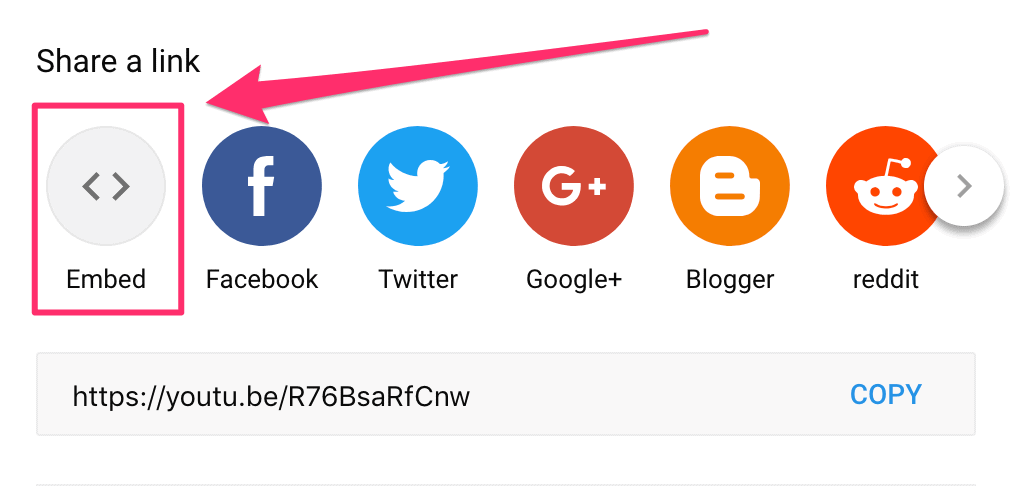
How To Do SEO for Your First Blog Post
On the next screen, copy the ‘iframe’ code:
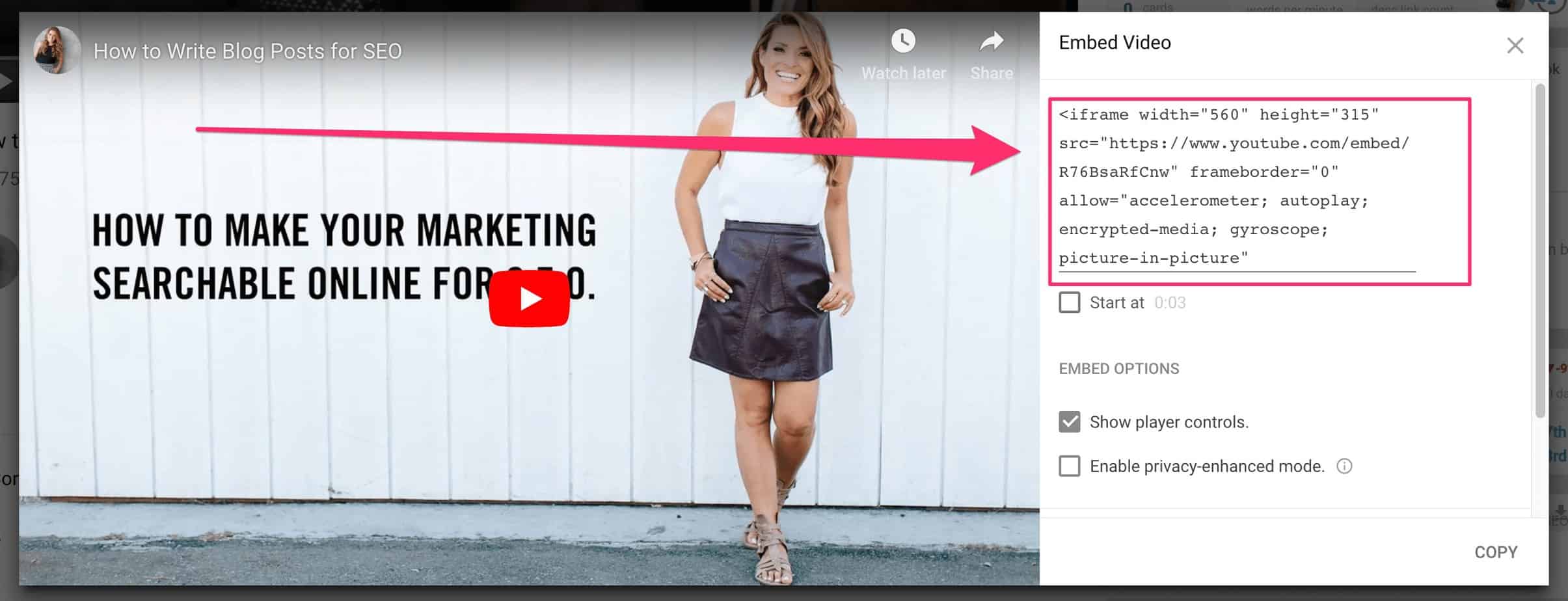
How To Do SEO for Your First Blog Post
Then look for the ‘Custom HTML’ widget in Gutenberg:
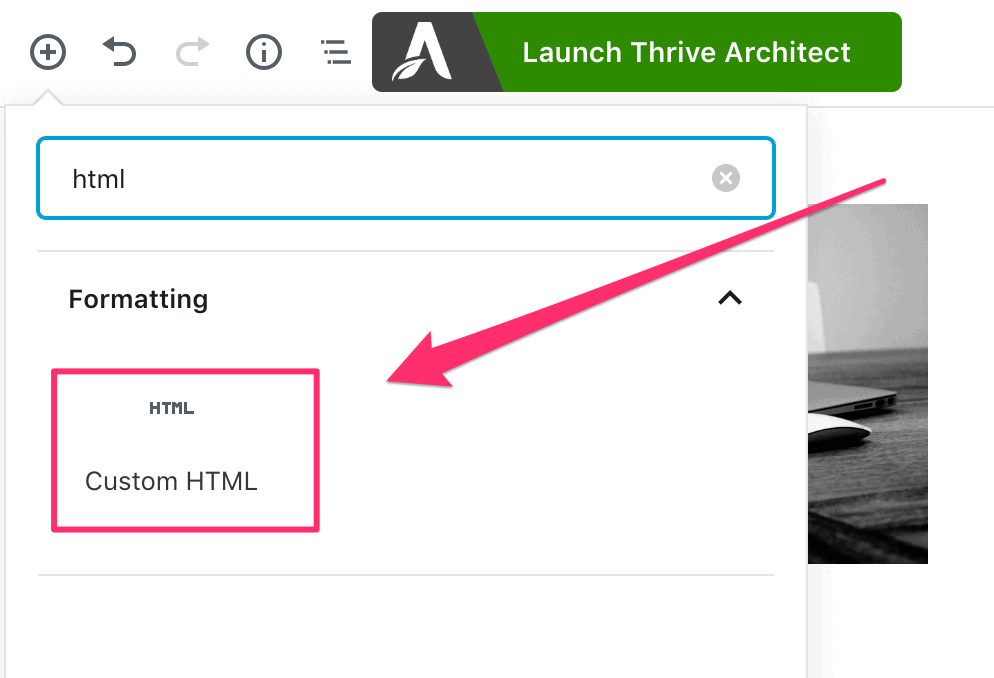
How To Do SEO for Your First Blog Post
Then drop that code into the Custom HTML widget:
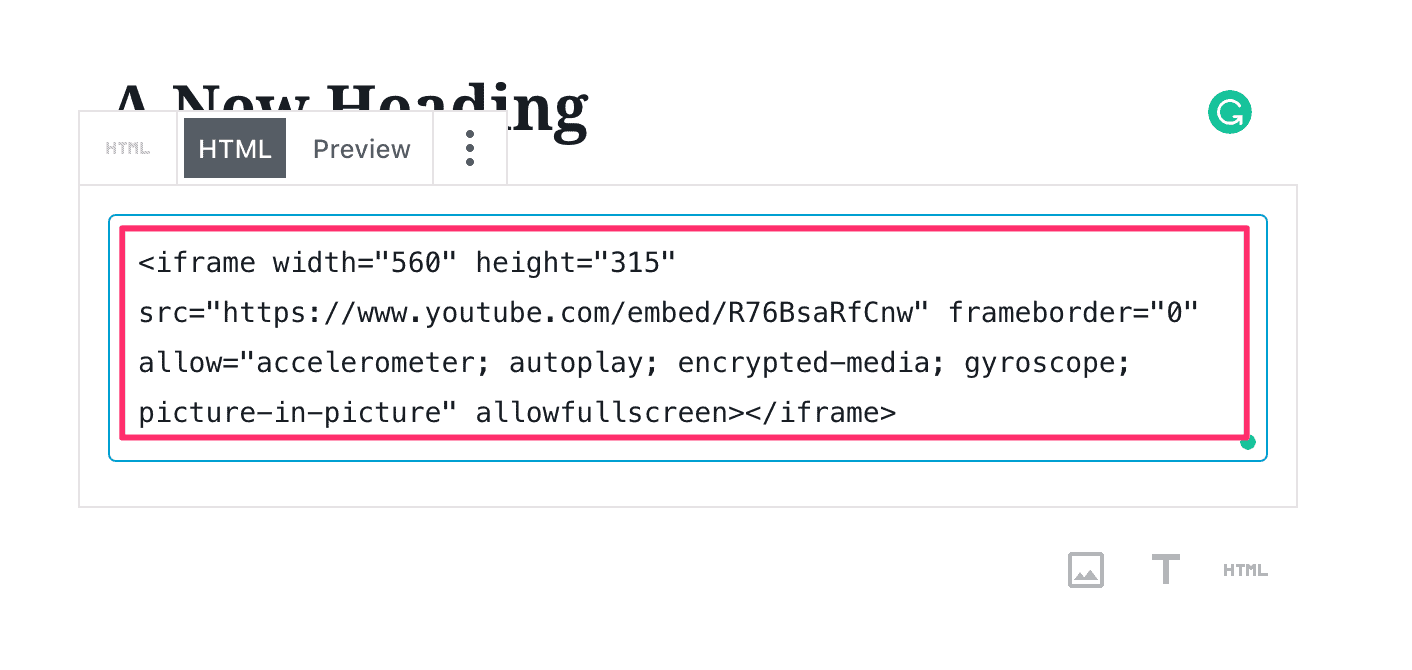
How To Do SEO for Your First Blog Post
You now have an embedded video within your blog post:

How To Do SEO for Your First Blog Post
#14. Write a Sizzling SEO Title
When you’re optimizing your article for SEO, you need to keep in mind the ‘SERP Snippet’ that appears in the search results.
This is what it looks like:
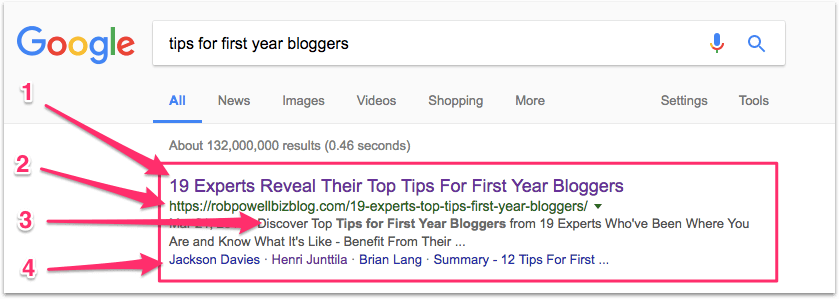
How To Do SEO for Your First Blog Post
The SERP Snippet consists of:
- the page or post title
- the URL of the page or post
- the meta description
- site Links (sometimes)
The title that appears in the search results doesn’t have to be identical to the actual title of your article.
You can customize your SEO title in the Yoast SEO Snippet tool:
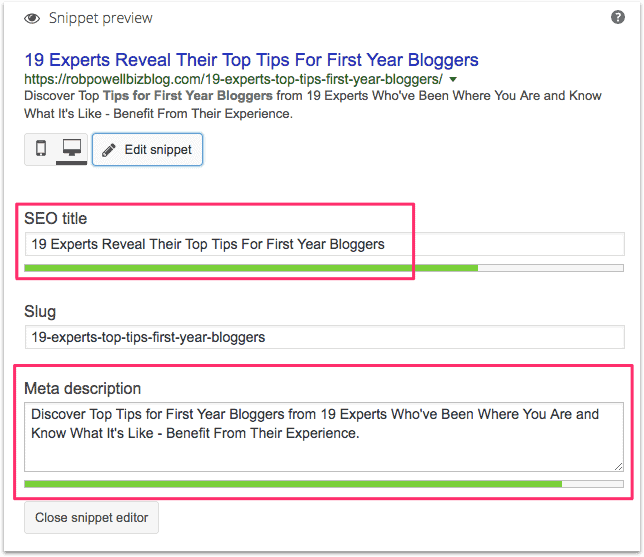
How To Do SEO for Your First Blog Post
When the Yoast SEO Title indicator turns green, you have the right number of words in your title.
Make sure to include your keyword as close to the beginning of the SEO title as you can. Also, use a ‘Power Word’ (such as free, amazing, best, proven, etc) in your SEO title.
#15. Write an Engaging Meta Description
The meta description is critical for your Google ranking.
In 160 characters you have to persuade the searcher that your link is worth clicking on:
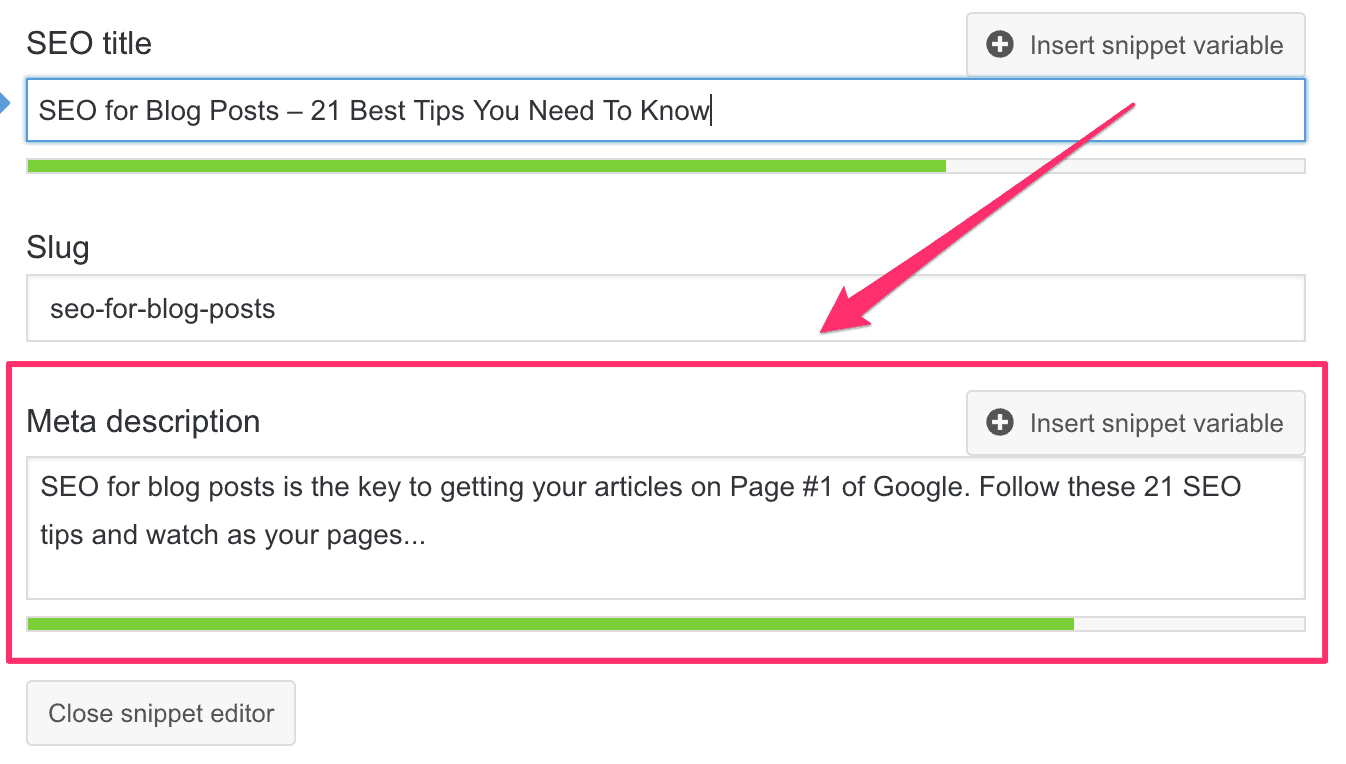
How To Do SEO for Your First Blog Post
Include your keyword phrase right at the beginning of your meta description.
That’s the first thing the searcher wants to know – is your content relevant to the search query they typed in?
In crafting a compelling meta description, the normal copywriting rules apply:
- use action words
- focus on benefits
- offer a solution to a problem
Also, try to include numbers in your SEO Title and special characters:
- 21 Cool Gift Ideas for Xmas 2018 (#6 Is Awesome)
- 37 Ways To Save Money in 2019 (That You Never Thought Of)
- 7 Keys To Losing Weight in Less Than 30 Days (Recipes Included)
#16. Put Your Keyword in the WordPress ‘Slug’
Here’s another important tip on how to write your first blog post: place your keyword in the URL.
The slug is the part of your web page URL that comes after the domain name. Make sure it contains your keyword:

How To Do SEO for Your First Blog Post
The slug should be as short as possible because Google gives preference to shorter URLs. Ideally, the slug should contain only your keyword.
#17. Promote Your Blog Post
Many bloggers will tell you that promoting your blog post is more important than the writing. You’ll often see people saying you should spend 50% of your time writing the post and 50% of your time promoting it.
But if you’ve done your SEO well, you don’t need to promote your article – Google will do that for you. In fact, that’s the whole point of SEO. If you get your article ranked on Page #1 of Google for your chosen keyword, your article promotes itself. And that leaves you with more time to produce your next piece of content.
Conclusion
So those are the key steps to follow when writing your first blog post. The most important of these tips is to find a keyword that you can rank for on Google.
Every blog post should start with keyword research, because every blog post should be trying to answer a query that someone has typed into Google.
Writing a great blog post isn’t all about formulas, and it isn’t all about being a great author. Like anything else, it’s a learned skill that you will get better at the more you practice.
Wishing you every success!
P.S. One of the keys to creating quality content quickly and efficiently is having a good drag-and-drop WordPress editor. The one I recommend, especially if you are starting out, is the free version of Elementor. It has all the core features you need to create professional looking blog posts.
More Articles About Writing
- Best Blog Post Format – 19 Tips for Formatting Online Content
- How To Structure a Blog Post – 13 Elements You Need
- How To Write Blog Posts: 10 Best Tips For Ranking on Google
- 21 Great Ideas For Your Next Blog Post
- How To Use Inverted Pyramid Writing for the Web
- How To Write Powerful Titles For Your Blog Posts – The Complete Guide
- How To Write a Blog Intro (The 4-Step Formula That Pulls Readers In)
- Catchy Titles for Articles – 21 Formulas That Work Like Magic
- The 7 Most Effective SEO Copywriting Tools For 2022
This was so helpful Rob. I even booked marked it for future reading. 🙂
Thanks for the feedback, Oliver, glad it was helpful 🙂 – Rob.
How can I publish my blog?
This is a good place to start:
How To Setup Your Own Blog (From Start To Finish)
Let me know if you have any other questions.
Regards – Rob
Thank you, Rob. it’s exactly what I was looking for .. I am going to write my first blog and i had no idea how to do it. I have been searching on google for two days to get an insight into it. after reading your blog, now I have a clear idea of what I am going to do and how am going to do it.
Thanks, Janet – I’m glad it was helpful. All the best, Rob.